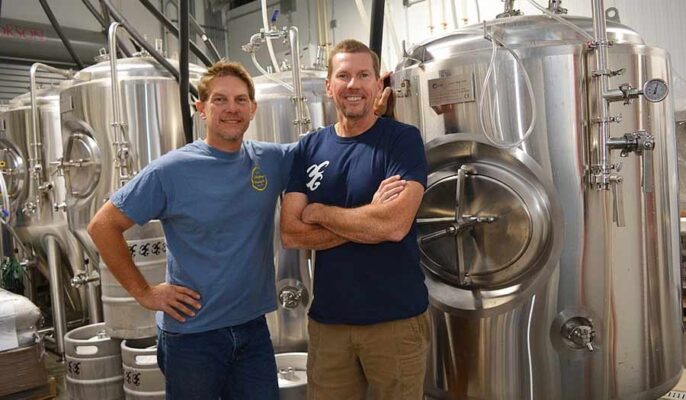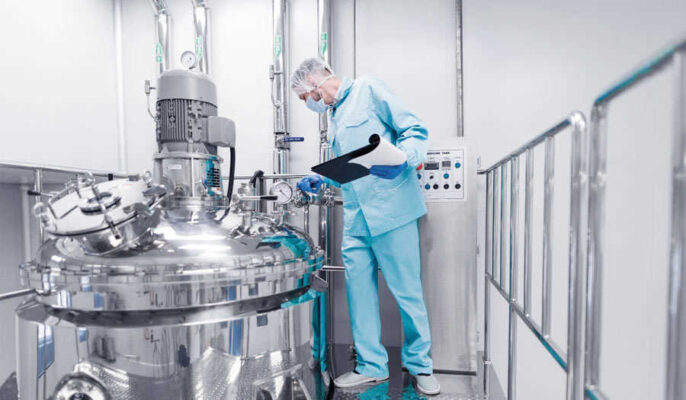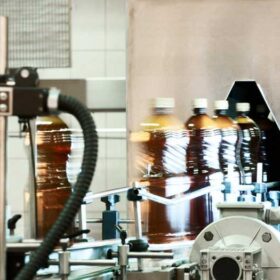The brewing process is an intricate dance of ingredients, time, and equipment, with fermentation playing a crucial role in determining the quality and flavor of the final product. At the heart of this process are brewery fermentation tanks, which provide the ideal environment for yeast to convert sugars into alcohol, carbon dioxide, and a range of flavors. In this article, we will explore the importance of brewery fermentation tanks, their design considerations, the fermentation process, monitoring and control systems, maintenance procedures, and their impact on beer quality. Let’s dive in!
1. Introduction to Brewery Fermentation Tanks
Brewery fermentation tanks are specialized vessels designed to facilitate the fermentation process during beer production. They provide a controlled environment where yeast can convert fermentable sugars from malted grains into alcohol and carbon dioxide. Additionally, the tanks allow for the development of unique flavors and desirable characteristics that define various beer styles.
2. Importance of Fermentation in Brewing
Fermentation is a crucial stage in the brewing process, where yeast metabolizes the sugars present in the wort, producing alcohol and carbon dioxide as byproducts. This transformative process not only imparts alcohol content to the beer but also creates a range of flavors and aromas. Proper fermentation is essential for achieving the desired beer style and ensuring consistency in taste from batch to batch.
3. Types of Brewery Fermentation Tanks
– Open Fermentation Tanks
Open fermentation tanks, also known as shallow vessels or fermenters, were traditionally used in brewing. These vessels have a large surface area exposed to the air, allowing for the exchange of gases during fermentation. While open fermentation can result in unique flavors, it also poses the risk of contamination and requires careful monitoring.
– Closed Fermentation Tanks
Closed fermentation tanks, as the name suggests, are sealed vessels that minimize the risk of contamination from outside sources. They provide a controlled environment for yeast to ferment the wort, preventing exposure to unwanted microorganisms. Closed tanks are widely used in modern breweries for their reliability and ability to produce consistent results.
– Conical Fermentation Tanks
Conical fermentation tanks are a popular choice in the brewing industry. Their unique shape allows for the separation of yeast and other sediment from the beer, making it easier to harvest and reuse yeast cultures. The conical design also facilitates the removal of unwanted solids, resulting in clearer and more refined beer.

4. Design Considerations for Brewery Fermentation Tanks
Fermentation tanks play a crucial role in the brewing process, and their design considerations greatly impact the quality and success of fermentation. Here are some key design considerations to ensure optimal fermentation conditions in brewery tanks:
Material Selection
Choosing the right material for fermentation tanks is essential for maintaining cleanliness and preventing contamination. Stainless steel is the preferred material due to its durability, resistance to corrosion, and ease of cleaning. The smooth surface of stainless steel prevents the adherence of bacteria and yeast, ensuring a hygienic environment for fermentation.
Size and Capacity
The size and capacity of fermentation tanks depend on the scale of the brewery and the desired production volume. It’s crucial to select tanks that are large enough to accommodate the fermentation process without overcrowding. Sufficient headspace should be available to account for the foaming and expansion that occur during active fermentation. Overfilling the tanks can lead to overflow, loss of product, and potential contamination.
Cooling and Insulation
Temperature control is vital for maintaining the desired yeast activity and avoiding off-flavors during fermentation. Fermentation tanks are often equipped with cooling jackets or temperature control systems that allow for precise regulation of the internal temperature. These cooling systems help maintain the ideal fermentation temperature range for the specific beer style being brewed. Insulation is also important to minimize heat exchange with the surrounding environment and maintain stable temperatures inside the tank. This not only improves energy efficiency but also reduces the risk of temperature fluctuations that could negatively impact fermentation.
Pressure Control
During fermentation, carbon dioxide is produced as a byproduct, creating pressure inside the tank. Proper pressure control is crucial to ensure the tank’s integrity and prevent any potential hazards. Brewery fermentation tanks incorporate pressure relief valves or adjustable pressure settings to release excess gas safely. This prevents over-pressurization, minimizes the risk of tank rupture, and maintains a controlled fermentation environment.
By considering these design aspects, breweries can optimize their fermentation process and achieve consistent and high-quality results. The right material selection, appropriate tank size and capacity, efficient cooling and insulation systems, and effective pressure control contribute to a successful and controlled fermentation process.
5. Fermentation Process in Brewery Tanks
The fermentation process is a vital stage in the production of beer, and brewery tanks provide the ideal environment for this transformative process. Let’s delve into the key steps involved in the fermentation process within brewery tanks:
- Yeast Addition Once the wort, a liquid extracted from malted grains, is transferred into the fermentation tank, yeast is added. This yeast, typically a specialized strain of Saccharomyces cerevisiae, begins its work by consuming the fermentable sugars present in the wort. As yeast metabolizes the sugars, it produces alcohol, carbon dioxide, and various flavor compounds. The yeast plays a fundamental role in shaping the final character and taste of the beer.
- Fermentation Temperature Maintaining the appropriate fermentation temperature is critical for optimal yeast activity and flavor development. Different beer styles have specific temperature requirements that contribute to their distinct characteristics. For example, ales typically ferment at warmer temperatures (around 18-22°C or 64-72°F), while lagers undergo fermentation at cooler temperatures (around 7-13°C or 45-55°F). Modern brewery tanks are equipped with precise temperature control systems, such as cooling jackets or glycol loops, allowing brewers to create the ideal environment for yeast activity and flavor formation.
- Duration of Fermentation The duration of fermentation varies based on factors such as the beer style, yeast strain, and desired characteristics. Ales generally have shorter fermentation periods, typically lasting around one to two weeks. Lagers, on the other hand, require longer fermentation times, ranging from several weeks to several months. During fermentation, the yeast actively converts sugars, and the flavors and aromas of the beer develop and mature. Brewers carefully monitor the progress of fermentation through gravity measurements and sensory evaluations to determine when the desired attenuation and flavor profile have been achieved.
Throughout the fermentation process, the yeast consumes the sugars, produces alcohol and carbon dioxide, and imparts unique flavors and aromas to the beer. Proper temperature control and fermentation duration are crucial for achieving the desired beer style and flavor profile. The brewery tanks provide a controlled environment where yeast can thrive, creating the foundation for a well-crafted and flavorful beer.
6. Monitoring and Control Systems
To maintain the quality and consistency of beer during the fermentation process, brewery tanks are equipped with various monitoring and control systems. These systems help brewers monitor key parameters and make necessary adjustments for optimal fermentation conditions. Here are some common monitoring and control systems used in fermentation tanks:
- pH Monitoring: Monitoring the pH level during fermentation is essential for assessing yeast health and ensuring optimal fermentation conditions. Yeast performs best within a specific pH range, typically around 4.2 to 4.8 for most beer styles. Regular pH measurements allow brewers to detect any deviations and take corrective actions if needed, ensuring a healthy fermentation process.
- Gravity Measurement: Gravity measurement involves regularly measuring the specific gravity of the fermenting beer using a hydrometer or refractometer. Specific gravity readings indicate the concentration of sugars remaining in the beer as fermentation progresses. By tracking gravity readings over time, brewers can monitor the progress of fermentation, determine the attenuation level, and predict the final alcohol content of the beer. This information helps them make informed decisions about when to proceed with the next stages of the brewing process, such as conditioning or packaging.
- Temperature Control: Maintaining precise control over fermentation temperatures is crucial for yeast activity and flavor development. Brewery tanks are equipped with temperature control systems, such as cooling jackets, glycol loops, or digital temperature controllers. These systems allow brewers to set and maintain the desired fermentation temperature, ensuring yeast operates within the optimal range for each beer style. Stable fermentation temperatures help control the rate of fermentation and influence the production of desirable flavors and aromas.
- Pressure Monitoring: Monitoring the pressure inside the fermentation tank is important for safety and process control. As yeast produces carbon dioxide during fermentation, pressure builds up inside the tank. Excessive pressure can lead to tank failure or off-flavors in the beer. Pressure relief valves, pressure sensors, or pressure gauges are installed on the tank to monitor and regulate the internal pressure. Brewers can adjust or release pressure as needed to maintain a safe and controlled fermentation environment.
These monitoring and control systems enable brewers to maintain precise control over key fermentation parameters, ensuring optimal yeast activity, flavor development, and overall beer quality. By regularly monitoring pH, gravity, temperature, and pressure, brewers can make timely adjustments and intervene if any deviations occur, leading to consistent and high-quality beer production.
7. Cleaning and Maintenance of Brewery Fermentation Tanks
Proper cleaning and maintenance of brewery fermentation tanks are essential for ensuring the production of high-quality and uncontaminated beer. Here are the key cleaning and maintenance procedures involved:
Cleaning Procedures:
After the completion of fermentation, the tanks undergo thorough cleaning to remove any residue, yeast, proteins, and other debris that may have accumulated during the fermentation process. The cleaning procedures typically involve several steps:
- Rinsing: The tanks are first rinsed with water to remove any loose debris and residues.
- Scrubbing: The tanks are then scrubbed using appropriate cleaning agents, brushes, or scrub pads to remove stubborn deposits. Care is taken to reach all areas of the tank, including hard-to-reach corners, dimples, and fittings.
- Sanitizing: After the tanks are thoroughly cleaned, sanitization is carried out to eliminate any remaining microorganisms that could potentially contaminate the next batch of beer. Sanitizing agents, such as food-grade sanitizers or disinfectants, are used to ensure a sterile environment.
Regular Maintenance:
In addition to cleaning, regular maintenance is crucial to ensure the proper functioning and longevity of the fermentation tanks. Some key maintenance procedures include:
- Valve and Fitting Inspection: The valves, fittings, and connections on the tanks are inspected regularly to ensure they are functioning correctly. Any leaks or signs of damage are identified and addressed promptly.
- Seal Checks: Seals, gaskets, and O-rings are examined to ensure they are intact and providing a proper seal. Damaged or worn-out seals are replaced to maintain airtight conditions.
- Visual Inspection: Regular visual inspections of the tanks are conducted to identify any signs of wear, corrosion, or damage. These inspections help detect potential issues early on and prevent further damage or contamination.
Proper cleaning and maintenance protocols are followed meticulously to minimize the risk of contamination, ensure consistent beer quality, and prolong the lifespan of the fermentation tanks. By adhering to these procedures, brewers create a clean and well-maintained environment for the fermentation process, which is essential for producing exceptional beers.
8. Importance of Proper Fermentation in Beer Quality
Proper fermentation is of utmost importance in ensuring the quality and characteristics of the final beer product. Here are key reasons why proper fermentation plays a crucial role:
1. Flavor Development: During fermentation, yeast produces a wide array of flavor compounds through the metabolism of sugars. These compounds contribute to the beer’s taste and aroma, giving it distinct and desirable flavors. The duration and temperature of fermentation, as well as the yeast strain used, greatly influence the flavor development. Proper fermentation management allows brewers to achieve the desired flavor profile, whether it’s the fruity esters of an ale or the clean, crisp flavors of a lager.
2. Alcohol Content: Yeast is responsible for converting the fermentable sugars present in the wort into alcohol. Proper fermentation ensures that yeast metabolizes an appropriate amount of sugars, leading to the desired alcohol content in the final beer. By carefully controlling fermentation parameters such as temperature, yeast pitch rate, and oxygen levels, brewers can achieve the intended alcohol level, ensuring a well-balanced beer without any excessive sweetness or harsh alcoholic flavors.
3. Carbonation: Fermentation generates carbon dioxide as a byproduct, which provides the beer with its characteristic carbonation. Controlling the fermentation process allows brewers to regulate the level of carbonation in the beer. This can range from a gentle effervescence in traditional ales to high levels of carbonation in sparkling beers or certain beer styles. Proper fermentation management ensures that the beer achieves the desired level of carbonation, contributing to its mouthfeel and overall sensory experience.
By paying close attention to fermentation parameters, such as yeast health, temperature control, and fermentation duration, brewers can achieve the optimal balance of flavors, alcohol content, and carbonation in their beers. Proper fermentation management is crucial for ensuring that each beer style exhibits its distinct characteristics, resulting in a high-quality, flavorful, and enjoyable drinking experience.
9. Innovations in Brewery Fermentation Tanks
The brewing industry continues to embrace technological advancements, and innovations in fermentation tank technology have significantly improved the brewing process. Here are some notable innovations:
1. Automated Fermentation Systems: Automation has revolutionized the fermentation process, allowing brewers to monitor and control multiple fermentation tanks simultaneously. Automated systems utilize sensors, actuators, and advanced software to regulate fermentation parameters such as temperature, pH, and dissolved oxygen levels. This automation streamlines operations, enhances process control, and ensures consistency across batches. Brewers can program precise temperature profiles, automate yeast nutrient additions, and monitor fermentation progress with ease, leading to improved efficiency and quality control.
2. Advanced Temperature Control: Temperature control is critical during fermentation, and advancements in technology have led to highly precise and customizable temperature control systems. These systems incorporate advanced temperature sensors, heating and cooling mechanisms, and sophisticated control algorithms. Brewers can now create and maintain specific temperature profiles throughout the fermentation process, allowing for precise control over yeast activity and flavor development. This level of control enables brewers to experiment with different fermentation conditions and produce beers with consistent and desired flavor profiles.
3. Real-Time Monitoring: Real-time monitoring systems have transformed the way brewers manage the fermentation process. These systems utilize sensors placed within the fermentation tanks to continuously monitor important parameters such as temperature, pH, gravity, and pressure. The data from these sensors is transmitted to a central monitoring system, providing brewers with immediate access to critical information. Real-time monitoring allows for proactive management, enabling brewers to make timely adjustments if any deviations or issues arise. This technology ensures optimal fermentation conditions, enhances quality control, and minimizes the risk of off-flavors or fermentation-related problems.
These innovations in fermentation tank technology have revolutionized the brewing industry, enabling brewers to achieve greater precision, efficiency, and consistency in the fermentation process. Automated systems, advanced temperature control, and real-time monitoring provide brewers with the tools and insights needed to produce high-quality beers with enhanced flavor profiles and improved overall quality.

10. Future Trends and Challenges in Brewery Fermentation
The future of brewery fermentation is marked by evolving trends and exciting challenges. Here are some areas of focus that are shaping the future of fermentation in the craft beer industry:
1. Sustainability: As sustainability becomes an integral part of the brewing industry, breweries are seeking ways to make their fermentation processes more environmentally friendly. They are adopting sustainable practices such as energy-efficient cooling systems, utilizing renewable energy sources, and implementing water-saving techniques. By reducing energy consumption and minimizing their environmental footprint, breweries are striving to create more sustainable fermentation practices.
2. Novel Yeast Strains: Brewers are continually exploring and experimenting with new and unique yeast strains. These novel yeast strains offer opportunities to create innovative and distinctive flavors in beer. By harnessing the characteristics of different yeast strains, brewers can expand the range of beer styles and create truly unique and memorable brews. These experiments with yeast strains allow brewers to push the boundaries of flavor and provide consumers with exciting and diverse options.
3. Non-Alcoholic Fermentation: The demand for non-alcoholic and low-alcohol beers is on the rise, leading to increased focus on fermentation techniques that produce flavorful non-alcoholic options. Brewers are exploring various fermentation methods, such as using specific yeast strains or adjusting fermentation conditions, to create non-alcoholic beers with complex flavors and satisfying mouthfeel. This segment of the market offers opportunities for breweries to cater to consumers seeking non-alcoholic alternatives while still providing an enjoyable drinking experience.
The future of brewery fermentation will be marked by a commitment to sustainability, experimentation with novel yeast strains, and the development of flavorful non-alcoholic options. Breweries that embrace these trends will be at the forefront of innovation, offering unique and environmentally conscious beers that cater to evolving consumer preferences.
11. Conclusion
Brewery fermentation tanks are essential equipment in the beer production process. They provide a controlled environment for yeast to work its magic, converting sugars into alcohol, carbon dioxide, and a plethora of flavors. The design considerations, monitoring systems, and maintenance procedures associated with fermentation tanks play a critical role in ensuring the quality and consistency of the final product. As technology advances, new innovations and trends continue to shape the future of brewery fermentation, allowing brewers to push the boundaries of flavor and create exceptional beers.






